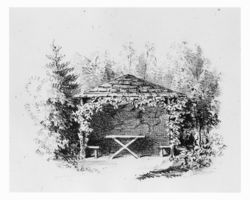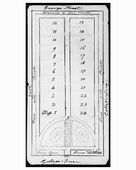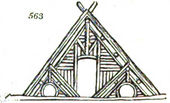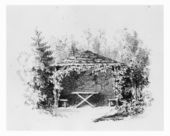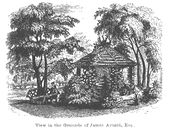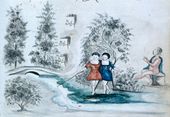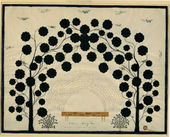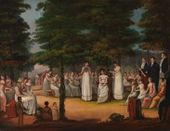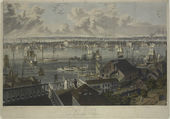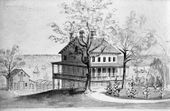Bower
(Bowery)
See also: Nursery
History

In 18th- and 19th-century landscape-design vocabulary, the term bower was closely related to arbor. The two features held several common characteristics: the use of intertwined trees and other vegetation, the creation of shaded areas, and their siting at the end of walks. Further refinement of this definition is complicated by the lack of explicit descriptive language in related accounts. William Faux’s 1819 description of Nathaniel Russell’s garden in Charleston, in which he simply notes bowers of flowering and fruit trees, or C. M. Hovey’s brief reference, in 1840, to a shady bower at James Arnold’s estate in New Bedford, Massachusetts, each represents this problem. In addition, a bower had similar functions to an arbor, such as serving as an outdoor living or dining space.
Nonetheless, some writers made distinctions between bowers and arbors. Noah Webster, for example, in 1828 specified that a bower had a centralized plan—round or square—whereas an arbor was long in plan and arched in cross-section. Manasseh Cutler's mention in 1787 of encircled bowers preceded this distinction. It should be noted, however, that this rule was not always followed. For example, A. J. Downing labeled many structures as arbors that were either round or square in form, and Fortescue Cuming, in 1810, described a “long frame bowery.” James E. Teschemacher’s 1835 definition of an arbor as an “artificial bower” indicated that for him the distinction was to be made between the man-made arbor and the natural bower.
In general, three different types of bowers can be identified. The first was composed of planted vegetation manipulated into a covered shelter, as described in 1755 by Samuel Johnson. An example of this type is a Shaker illustration of 1854 of a bower constructed of intertwined trees and used as a dining setting [Fig. 1].[1] A bower described in the Virginia Argus (1799) as suitable “for the accommodation of company” may have been similar in form and size to this Shaker bower.
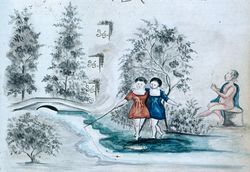
The second type was a built structure over which vegetation was trained. William Byrd II’s 1728 description of a habitation of a “Marooner” is an early instance of a bower being defined as a constructed shelter. Teschemacher gives a detailed account (1835) of the construction of a 19th-century bower, one in which iron arches were covered with climbing vines. In 1806, Bernard M’Mahon specified that bowers were “light ornamental buildings” suitable for terminating garden walks [Fig. 2] or complementing open grassy areas in the garden. William Dickinson Martin, in 1809, referred to a “neatly built” bower and William Bailey Lang in 1845 noted a rustic bower that had a shingle roof, with a corner post of rough cedar, “to which that hardy-plant, the Virginia creeper, has been trained.” A. J. Downing also advised in 1848 that such bowers could be “easily and economically constructed,” an idea for rustic buildings that was shared by M’Mahon (1806).
An important difference, however, marks M’Mahon’s and Downing’s references to constructed bowers. M’Mahon argued that such features were appropriate for “spacious pleasure grounds,” while Downing limited their use to more “humble and simple cottage grounds, the rural walks of the ferme ornée, and the modest garden of the suburban amateur.” Downing’s sentiments reflect the increasing attention paid to style and decorum by 19th-century treatise writers and suggest that bowers were associated with the rustic-style gardens that doubled as both aesthetic and utilitarian spaces. Such distinctions were not without precedent: In 1804 Thomas Jefferson commented that bowers were more suitable for a kitchen garden than for pleasure grounds.
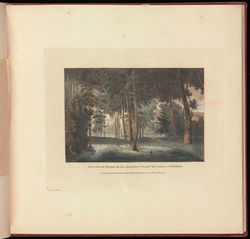
The third type of bower, a naturally occurring and seemingly unmanipulated collection of trees and shrubs creating a shady enclave or space, is well documented in both descriptions and images of American gardens. For example, Lewis Miller’s mid-19th century poem about “bowery shade” is illustrated with an image of two girls nestled underneath the curving branches of a small tree, which constitutes such a bower [Fig. 3]. The “Elysian Bower” at Springland, near Bristol, Pennsylvania, illustrated in an 1808 view, exemplifies the application of this term to a secluded gathering of shade trees [Fig. 4].
As a final note, one of Noah Webster's definitions for bower was for “a country seat; a cottage.” To date, no example of this use of bower has been found. This absence confirms the observation that although treatise writers and lexicographers set forth specific definitions of bower, observers of the American landscape tended to use the term to mean simply a specific natural or artificially constructed shady space occurring either in a garden or landscape.
—Anne L. Helmreich
Texts
Usage
- Byrd, William, II, 1728, describing the border of Virginia and North Carolina (quoted in Lounsbury 1994: 41)[2]
- “. . . not far from the Inlet, dwelt a Marooner, that Modestly call’d himself a Hermit, tho’ he forfeited that Name by Suffering a wanton Female to cohabit with Him. His Habitation was a Bower, cover’d with Bark after the Indian Fashion, which in that mild Situation protected him pretty well from the Weather.”
- Jefferson, Thomas, April 9, 1786, describing the gardens at Blenheim Palace, estate of the Duke of Marlborough, Woodstock, Oxfordshire, England (1944: 114)[3]
- “Rosamund’s bower was near where is now a little grove, about two hundred yards from the palace. The well is near where the bower was.”
- Cutler, Manasseh, July 14, 1787, describing Gray’s Tavern, Philadelphia, PA (1987: 1:275)[4]
- “We then rambled over the Gardens, which are large—seemed to be in a number of detached areas, all different in size and form. The alleys were none of them straight, nor were there any two alike. At every end, side, and corner, there were summer-houses, arbors covered with vines or flowers, or shady bowers encircled with trees and flowering shrubs, each of which was formed in a different taste.”
- Anonymous, June 7, 1799, describing a property for sale near Richmond, VA (Virginia Argus)
- “Valuable Property FOR Sale at the Bowling Green, near Richmond, that much frequented Tavern and public Garden. . . The garden is very extensive. . . with Summer Houses, and bowers for the accommodation of company.”
- Jefferson, Thomas, 1804, describing Monticello, plantation of Thomas Jefferson, Charlottesville, VA (quoted in Nichols and Griswold 1978: 110–11)[5]
- “At the Rocks. . . a turning Tuscan temple. . . proportions of Pantheon, . . . at the Point, . . . build Demosthenes’s lantern. . . The kitchen garden is not the place for ornaments of this kind. bowers and treillages suit that better, & these temples will be better disposed in the pleasure grounds.”
- Martin, William Dickinson, c. 1809, describing the garden of a tavern keeper in Salisbury, NC (quoted in Lounsbury 1994: 41)[2]
- “In the centre of the Garden. . . was a handsome bower, neatly built, & adorned with English Honey Suckle, Woodbine & a few Jessamine.”
- Cuming, Fortescue, 1810, describing Canonsburgh, PA (quoted in Cummings 1949: 217, 227)[6]
- “The most striking thing I saw here was my Landlord’s garden, which is both good and handsome, being laid out with taste, abounding in a variety of the best culinary vegetables, and having some very pleasant shady bowers, where the student, or man of leisure, sheltered from the noonday sun, and inhaling the fragrance of the surrounding aromatick [sic] plants might luxuriantly roam into the realms of fancy.”
- “What adds to the beauty of Mr. Tannehill’s seat is, a handsome grove of about two acres of young black oaks, northwest of his dwelling, through the middle of which runs a long frame bowery, on whose end fronting the road, is seen this motto, ‘1808, Dedicated to Virtue, Liberty, and Independence’ Here a portion of the citizens meet on each 4th of July, to hail with joyful hearts the day that gave birth to the liberties and happiness of their country.”
- Smith, Margaret Bayard, 1811, describing Sidney, summer retreat of Margaret Bayard Smith, near Washington, DC (1906: 88)[7]
- “When Mr. Tracy, (who was an important personage on the occasion) brought the cart to the door Lytleton and all the boys jump’d in it and went to the woods for boughs. L. drove furiously along to the no small delight of the boys and soon return’d like the moving wood in Macbeth. The Piazza was soon transform’d into a bower, —every hand was busy, —Mrs. Clay, Mr. Smith and all.”
- Wilson, Alexander, before 1813, describing Gray’s Garden, Philadelphia, PA (quoted in Adams 1976: 339)[8]
- “There market-maids in lovely row,
- With wallets white, were riding
- home,
- With wallets white, were riding
- “And thund’ring gigs, with powdered
- beaux,
- Through Gray’s green festive
- shade to roam.
- “Sweet flows the Schuylkill’s winding
- tide
- By Bartram’s emblossomed
- bowers.
- “Where nature sports in all her pride
- Of choicest plants and fruits and
- flowers.”
- Of choicest plants and fruits and
- Faux, William, 1819, describing the garden of Nathaniel Russell, Charleston, SC (quoted in Lounsbury 1994: 41)[2]
- “[An English visitor in Charleston] called on the venerable Nathaniel Russell, Esq., residing in a splendid mansion, surrounded by a wilderness of flowers and bowers of myrtles, oranges and lemons, smothered with fruit and flowers.”
- du Pont, Sophie Madeleine, 1828, describing Eleutherian Mills, estate of Eleuthère Irénée du Pont, near Wilmington, DE (quoted in Low and Hinsley 1987: 38)[9]
- “I thought of other Maydays; long past, when you and I were little children—of our walks, and our plays—our bowers, mudhouses, and forts, and the little fleet of boats we used to sail upon the pond—I could not help feeling sad when I thought of how we were changed—we, that once played together, walked together, studied our little lessons in partnership.”
- Wailes, Benjamin L. C., December 29, 1829, describing Lemon Hill, estate of Henry Pratt, Philadelphia, PA (quoted in Moore 1954: 359)[10]
- “But the most enchanting prospect is towards the grand pleasure grove & green house of a Mr. Prat[t], a gentleman of fortune, and to this we next proceeded by a circutous rout [sic], passing in view of the fish ponds, bowers, rustic retreats, summer houses, fountains, grotto, &c., &c.”
- Committee of the Pennsylvania Horticultural Society, 1830, describing Lemon Hill, estate of Henry Pratt, Philadelphia, PA (quoted in Boyd 1929: 432)[11]
- “There are some pretty bowers, summer houses, grottos and fish ponds in this garden—the latter well stored with gold and silver fish.”
- Dearborn, H. A. S., 1832, describing Mount Auburn Cemetery, Cambridge, MA (quoted in Harris 1832: 68)[12]
- “To those who mourn, what a consolation to visit the bower-sequestered monument of a much loved friend, under circumstances and with associations so favorably calculated to revive agreeable recollections of the past; and when those revolting ideas are excluded, which obtrude upon the mind, while standing in the usually dreary, desolate, and ruinous repositories of the dead.”
- Hovey, C. M. (Charles Mason), September 1840, “Notes on Gardens and Gardening, in New Bedford, Mass.,” describing the residence of James Arnold, New Bedford, MA (Magazine of Horticulture 6: 364)[13]
- “Continuing through the winding walks, shady bowers, and umbrageous retreats, through which rustic seats were placed, we arrived at the shell grotto.”
- Lang, William Bailey, 1845, describing a rustic bower in Butte, MA, in Views with Ground Plans (1845: 18)[14]
- “The Rustic Bower.—Shingle roof, painted black. The corner post of the rough cedder, to which that hardy-plant, the Virginia creeper, has been trained.” [Fig. 5]
- Earle, Pliny, January 1848, describing Bloomingdale Asylum for the Insane, New York, NY (Journal of Medicine 10: 63)
- “Airing Courts, or Yards.—There are three of these courts for the men, and four for the women. They are, with one exception, well shaded with trees, and three of them have large bowers covered with roofs, and furnished with seats for all the patients admitted into the courts.”
- Downing, Andrew Jackson, 1849, describing the residence of James Arnold, New Bedford, MA (1849; repr.,1991: 57)[15]
- “In the environs of New Bedford are many beautiful residences. Among these, we desire particularly to notice the residence of James Arnold, Esq. There is scarcely a small place in New England, where the pleasure-grounds are so full of variety, and in such perfect order and keeping, as at this charming spot; and its winding walks, open bits of lawn, shrubs and plants grouped on turf, shady bowers, and rustic seats, all most agreeably combined, render this a very interesting and instructive suburban seat.”
Citations
- Johnson, Samuel, 1755, A Dictionary of the English Language (1755: 1:n.p.)[16]
- “BOWER. n. s. [from bough or branch, or from the verb to bow or bend.]
- “1. An arbour; a sheltered place covered with green trees, twined and bent.”
- M’Mahon, Bernard, 1806, The American Gardener’s Calendar (1806: 64)[17]
- “In some spacious pleasure-grounds various light ornamental buildings and erections are introduced, as ornaments to particular departments; such as temples, bowers, banquetting houses, alcoves, grottos, rural seats, cottages, fountains, obelisks, statues, and other edifices; these and the like are usually erected in the different parts, in openings between the divisions of the ground, and contiguous to the terminations of grand walks, &c.
- “Some of these kinds of ornaments, however, being very expensive, are rather sparingly introduced; sometimes a temple is presented at the termination of a grand walk or opening, or sometimes a temple, banqueting-house, or bower is erected in the centre of some spacious opening or grass-ground in the internal divisions; other parts present alcoves, bowers, grottos, rural-seats, &c. at the termination of different walks.”
- Loudon, J. C. (John Claudius), 1826, An Encyclopaedia of Gardening (1826: 809)[18]
- “6157. . . Light bowers formed of lattice-work, and covered with climbers, are in general most suitable to parterres; plain covered seats suit the general walks of the shrubbery.”
- Prince, William, 1828, A Short Treatise on Horticulture (1828: 87, 88, 145–47, 149)[19]
- “Clematis virginica, or Virginian Virgin’s Bower.—This is of most rapid growth, and produces, in July and August, a great abundance of white flowers, which are very fragrant; it is well calculated to cover arbours and bowers. . .
- “Clematis viticella, or European Virgin’s Bower.—This is a native of the south of Europe, and is greatly admired as a vine for covering bowers, or training against the sides of houses, or in other situations where vines are wanted. . .
- “Sweetbriar, or Eglantine.—This delightful species of the rose family is well calculated to train against the sides of houses, or up the pillars of the piazza, or to intermingle with the vines which entwine bowers, &c. . .
- “The Champney, Noisette, [rose] and most of the varieties, may be trained against the sides of houses, over bowers, &c. to a very considerable length, although not quite so rampant in their growth as the different varieties of the Multiflora. . .
- “The climbing, or running roses, suitable to train against buildings, or on arbours, bowers, &c. are the following:—Common Multiflora, Roxburgh’s White Multiflora, Lady Banks’ Double White, Greville’s Superb, Champneys, Noisette, Boursaultian, Hybrid, Macartney’s, &c. . .”
- Webster, Noah, 1828, An American Dictionary of the English Language (1828: 1:n.p.)[20]
- “BOW'ER, n. [Sax. bur, a chamber or private apartment, a hut, a cottage; W. bwr, an inclosure.]
- “1. A shelter or covered place in a garden, made with boughs of trees bent and twined together. It differs from arbor in that it may be round or square, whereas an arbor is long and arched. Milton. Encyc.
- “2. A bed-chamber; any room in a house except the hall. Spencer. Mason.
- “3. A country seat; a cottage. Shenston., B. Johnson.
- “4. A shady recess; a plantation for shade. W. Brown. . .
- “BOW’ERY, a. Covering; shading as a bower; also, containing bowers. Thomson.”
- Teschemacher, James E., August 1, 1835, “Extracts from Foreign Publications” (Horticultural Register 1: 308–9)[21]
- “From an article On the various form and character of Arbours as objects of use or ornament either in gardens or wild scenery [from Paxton’s Horticultural Register], we extract the following passages.
- “‘A singularly beautiful structure which may be classed with this kind of garden decoration has been made in Ireland.
- “‘A circular space of about sixty feet diameter, in the centre of dressed ground with scattered clumps of evergreen shrubs, surrounded by lofty trees, is wholly enclosed by a continued arcade of iron arches. . . All the arches are thickly covered with climbing plants of strong rapid growth, which proceed along the wires to the top of the pole. . .
- “‘The interior is an arbor of great magnitude, not so closely covered as everywhere absolutely to exclude the sun, but yet so as to render it always shady and agreeable. . .
- “‘The entire effect is good, and this may be considered as one of the best specimens of the artificial bower of the present day.’”
- Johnson, George William, 1847, A Dictionary of Modern Gardening (1857: 98)[22]
- “BOWER. See Arbor.”
- Downing, A. J., February 1848, “Hints and Designs for Rustic Buildings” (Horticulturist 2: 363–64)[23]
- “But the more humble and simple cottage grounds, the rural walks of the ferme ornée, and the modest garden of the suburban amateur, have also their ornamental objects and rural buildings—in their place, as charming and spirited as the more artistical embellishments which surround the palladian villa.
- “These are the seats, bowers, grottoes and arbors, of rustic work—than which nothing can be more easily and economically constructed, nor can add more to the rural or picturesque expression of the scene.
- “Those simple buildings, often constructed only of a few logs and twisted limbs of trees, are in good keeping with the simplest or the grandest forms of nature.”
- Elder, Walter, 1849, The Cottage Garden of America (1849: 219)[24]
- “A. What place is that covered with roses and Honeysuckles?
- “B. That’s a shady bower with seats in it.
- “A. Is that another shady bower, covered with sweet scented clematis and roses?
- “B. That’s a building for the use of the family.”
- Miller, Lewis, c. 1850, description on a drawing of an idealized scene in the Orbis Pictus (Abby Aldrich Rockefeller Folk Art Center, Colonial Williamsburg Foundation)
- “While the fish, A narrow vista, carpeted with rich— green grass. invites my tread: here Showers light in golden dots. So blended, that the very air
- Seems network as i enter there. On each Side Shrinks the bowery Shade: Before me Spreads an Emerald glade.” [See Fig. 3]
Images
Inscribed
Solomon Drowne, Detailed plan of a botanic garden at Brown University, n.d.
William Russell Birch, “View from the Elysian Bower, Springland, Pennsylvna the residence of Mr W. Birch,” 1808, in The Country Seats of the United States (2009), 81, pl. 20.
Solomon Drowne, Botanic Garden, 1818, 1818. The "bower" inscription can be found between the "shrubbery" and "college inclosure" inscriptions, to the right.
Anonymous, “View in the Grounds of James Arnold, Esq.” in A. J. Downing, A Treatise on the Theory and Practice of Landscape Gardening (1849), pl. opp. 57.
Lewis Miller, “A narrow vista carpeted with rich green grass. . . on each side shrinks the bowery shade. . . ” [detail], in Orbis Pictus, c. 1850.
Attributed
Amy Cox, attr., Box Grove, c. 1800.
Notes
- ↑ This image may allude to feast grounds built by Shaker communities at mid-century. For more about Shaker imagery, see Sally M. Promey, Spiritual Spectacles: Vision and Image in Mid-Nineteenth-Century Shakerism (Bloomington: Indiana University Press, 1993), view on Zotero.
- ↑ 2.0 2.1 2.2 Carl R. Lounsbury, ed., An Illustrated Glossary of Early Southern Architecture and Landscape (New York: Oxford University Press, 1994), view on Zotero.
- ↑ Thomas Jefferson, The Garden Book, ed. by Edwin M. Betts (Philadelphia: American Philosophical Society, 1944), view on Zotero.
- ↑ William Parker Cutler, Life, Journals, and Correspondence of Rev. Manasseh Cutler, LL.D. (Athens, OH: Ohio University Press, 1987), view on Zotero.
- ↑ Frederick Doveton Nichols and Ralph E. Griswold, Thomas Jefferson, Landscape Architect (Charlottesville: University Press of Virginia, 1978), view on Zotero.
- ↑ Richard O. Cummings, The American Ice Harvests: A Historical Study in Technology, 1800–1918 (Berkeley, CA: University of California Press, 1949), view on Zotero.
- ↑ Margaret Bayard Smith, The First Forty Years of Washington Society, ed. Gaillard Hunt (New York: Charles Scribner’s, 1906), view on Zotero.
- ↑ William Howard Adams, ed., The Eye of Thomas Jefferson (Washington, DC: National Gallery of Art, 1976), view on Zotero.
- ↑ Betty-Bright Low and Jacqueline Hinsley, Sophie du Pont, A Young Lady in America: Sketches, Diaries, & Letters, 1823–1833 (New York: Harry N. Abrams, 1987), view on Zotero.
- ↑ John Hebron Moore, “A View of Philadelphia in 1829: Selections from the Journal of B. L. C. Wailes of Natchez,” Pennsylvania Magazine of History and Biography, 78 (July 1954), 353–60, view on Zotero.
- ↑ James Boyd, A History of the Pennsylvania Horticultural Society, 1827–1927 (Philadelphia: Pennsylvania Horticultural Society, 1929), view on Zotero.
- ↑ Thaddeus William Harris, A Discourse Delivered before the Massachusetts Horticultural Society on the Celebration of Its Fourth Anniversary, October 3, 1832 (Cambridge, MA: E. W. Metcalf, 1832), view on Zotero.
- ↑ Charles Mason Hovey, “Notes on Gardens and Gardening, in New Bedford, Mass.,” Magazine of Horticulture, Botany, and All Useful Discoveries and Improvements in Rural Affairs 6, no. 9 (September 1840): 361–66, view on Zotero.
- ↑ William Bailey Lang, Views with Ground Plans, of the Highlands Cottages at Roxbury (Boston: L. H. Bridgham and H. E. Felch, 1845), view on Zotero.
- ↑ A. J. [Andrew Jackson] Downing, A Treatise on the Theory and Practice of Landscape Gardening, Adapted to North America, 4th ed. (1849; repr. Washington, DC: Dumbarton Oaks Research Library and Collection, 1991), view on Zotero.
- ↑ Samuel Johnson, A Dictionary of the English Language: In Which the Words Are Deduced from the Originals and Illustrated in the Different Significations by Examples from the Best Writers, 2 vols. (London: W. Strahan for J. and P. Knapton, 1755), view on Zotero.
- ↑ Bernard M'Mahon, The American Gardener’s Calendar: Adapted to the Climates and Seasons of the United States. Containing a Complete Account of All the Work Necessary to Be Done. . . for Every Month of the Year. . . (Philadelphia: Printed by B. Graves for the author, 1806), view on Zotero.
- ↑ J. C. (John Claudius) Loudon, An Encyclopaedia of Gardening; Comprising the Theory and Practice of Horticulture, Floriculture, Arboriculture, and Landscape-Gardening, 4th ed. (London: Longman et al., 1826), view on Zotero.
- ↑ William Prince, A Short Treatise on Horticulture (New York: T. and J. Swords, 1828), view on Zotero.
- ↑ Noah Webster, An American Dictionary of the English Language, 2 vols. (New York: S. Converse, 1828), view on Zotero.
- ↑ James E. Teschemacher, “Extracts from Foreign Publications,” Horticultural Register, and Gardener’s Magazine 1 (August 1, 1835), 304–9, view on Zotero.
- ↑ George William Johnson, A Dictionary of Modern Gardening, ed. David Landreth (Philadelphia: Lea and Blanchard, 1847), view on Zotero.
- ↑ A. J. Downing, “Hints and Designs for Rustic Buildings,” Horticulturist and Journal of Rural Art and Rural Taste 2, no. 8 (February 1848): 363–65, view on Zotero.
- ↑ Walter Elder, The Cottage Garden of America (Philadelphia: Moss, 1849), view on Zotero.

